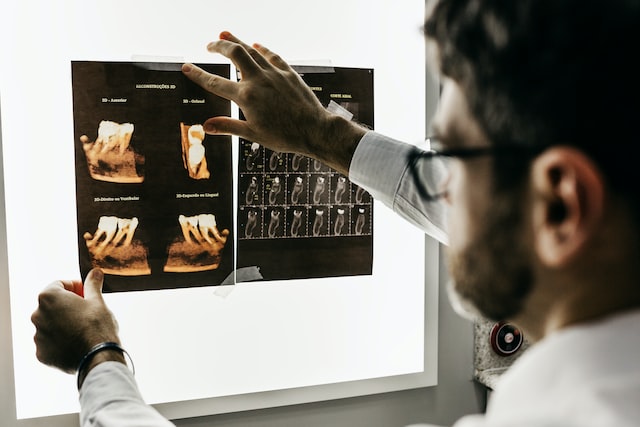
Technology is ever-evolving in the field of dentistry. Today, when you visit an oral and maxillofacial surgeon for oral surgery in Texas, you will find that there is a lot of high-tech equipment being worked with. This technology allows surgeons to take data with them directly into the operating room. With this data, they are able to customize unique surgical plans for their patients. At its core, the use of dental technology provides clarity. One critical piece of equipment that achieves this sense of clarity, thanks to its incredible accuracy, is a dental X-ray. With that in mind, here is everything you need to know about getting X-rays done by an oral and maxillofacial surgeon.
Did you know that X-rays were first discovered in 1895? Even more interesting is that Wilhelm Roentgen, a physics professor in Bavaria, discovered them by accident. He decided to use the letter “X” in the name to signify the unknown. The ironic part about this is that X-rays intend to solve the unknown.
Oral exams do not always find the root of oral problems. This means that it can be difficult to determine diagnoses and create effective treatment plans. To receive these from your oral and maxillofacial surgeon, you must have a dental X-ray done. It will spot trouble early on so that, in the event that you need oral surgery in Texas, you can consult with an oral surgeon before the issue persists.
It is common practice for your dentist to suggest that you receive X-rays. However, you may be familiar with the fact that X-rays use radiation. This technology has come a long way since Wilhelm Roentgen’s discovery, both in the medical and dental fields. We now have a significantly stronger understanding of radiation, which enables professionals to mitigate exposure to patients. Proper safety features and procedures have been developed, such as lead aprons and leaded thyroid collars to help reduce these risks.
In addition, there have been huge improvements in the machines used to take radiographs which helps to decrease not only the amount of radiation needed to take a radiograph, but also to decrease patient exposure and risk. But at the end of the day, what you need to know is that the small amount of radiation involved in an X-ray is far less impactful than the reason you are getting oral surgery in Texas.
You will need an X-ray prior to any oral surgery in Texas. Oral surgeons use X-rays to get a better sense of your current oral health.
Oral and maxillofacial surgeons are highly equipped to use advanced technology during oral surgeries in Texas. In addition to conventional 2D radiographs, Dr. Jeff Alford is able to take 3D CT scan radiographs at both the Lake Travis Oral Surgery and Bastrop Oral Surgery locations. In order to be prepared for your upcoming X-ray, you should know when you will need different types of imaging. Not all dental X-rays are the same, although they do share the same outcome of locating and diagnosing problems. Here are some of the types of imaging technology used by oral surgeons.
Digital X-ray sensors are much faster than conventional X-rays. With this 2D dental imaging, images of your mouth will be sent directly to a computer. This image can be enlarged and enhanced to make it easier for an oral surgeon to see small changes in detail. All radiographs taken at Lake Travis Oral Surgery and Bastrop Oral surgery locations are digital, which provides the best image while only using a fraction of the radiation that the old radiographs required.
These are specialized images taken by your dentist to look for cavities between your teeth. They show the details of both your upper and lower teeth in one particular area of your mouth. Oral surgeons get to see a tooth from its crown to its supporting bone.
These are close-up images of typically 1-3 teeth. They are useful in helping to diagnose and manage dental problems prior to oral surgery in Texas.
Valuable information is gained from panoramic X-rays because they cover a wider area than conventional bite wing or periapical X-rays. With this examination, oral surgeons can plan treatments for dental implants, extractions, and partial and complete dentures. They are even able to see impacted teeth.
Dr. Jeff Alford uses cone beam computed tomography (CT). This is a special type of machine that generates 3D images of your craniofacial region. A 3D cone beam CT has become the gold standard for implant dentistry and jaw surgery. This cone beam scan allows Dr. Alford to see structures in every dimension so that your surgery can be performed in the most efficient and safe manner possible This advanced technology is available at both Lake Travis Oral Surgery and Bastrop Oral Surgery locations.
Here in the Heart of Texas, you will receive the best treatment during and after your surgery. Dr. Alford is a highly-skilled dental professional who keeps up with the latest advances in knowledge. With his help, you are sure to maximize your most desired outcome. Services of Dr. Alford include wisdom teeth removal surgery, dental implants, oral pathology, pre-prosthetic surgery, Botox injections for bruxism (teeth grinding), and corrective jaw surgery. No matter your situation, expect to have transparent communication and a comfortable environment. Request a consultation for your oral surgery in Texas at either Lake Travis Oral Surgery or Bastrop Oral Surgery.